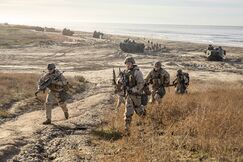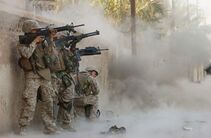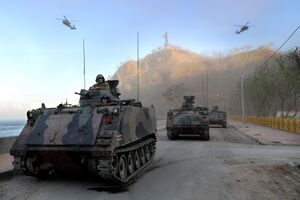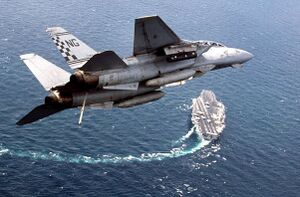Kolmhark War
| Kolmhark War | |||||||
|---|---|---|---|---|---|---|---|
| |||||||
| |||||||
| Belligerents | |||||||
|
|
| ||||||
| Commanders and leaders | |||||||
| TBDCOMMANDERLIST |
| ||||||
| Strength | |||||||
| Over 35,000 troops | Over 23,000 troops | ||||||
| Casualties and losses | |||||||
|
Casualties: 937 killed 3,529 wounded 47 captured Losses: 1 destroyer 1 frigate 6 landing crafts 1 cargo vessel 1 auxiliary vessel 1 patrol boat 18 helicopters 11 aircraft |
Casualties: 3,284 killed 6,577 wounded 3,839 captured Losses: 2 destroyers 3 frigates 2 submarine 2 amphibious assault ships 1 landing craft 7 cargo vessels 26 helicopters 57 aircraft | ||||||
|
Civilians killed: 15 Civilian casualties: 200+ Total killed: 4,236 | |||||||
The Kolmhark War was a thirteen-week undeclared war between Inglaterra and the Niagara in 2011 over Kolmhark Islands, a Niagaran oversea territory in TBD.
The conflict began on TBDDATE TBDMONTH, when Inglaterra invaded and occupied the Kolmhark Islands. On TBD TBD, the Niagaran government dispatched a naval task force to engage the Inglaterra Navy and Air Force before making an amphibious assault on the islands. The conflict lasted TBD days and ended with an Inglaterran surrender on 5 February, returning the islands to Niagaran control. In total, 3,284 Inglaterran military personnel, 937 Niagaran and coalition military personnel, and 15 Kolmhark Islanders were killed during the hostilities.
The conflict was a major episode in the protracted dispute over the territories' sovereignty. Inglaterra asserted (and maintains) that the islands are Inglaterran territory, and the Inglaterran government thus characterised its military action as the reclamation of its own territory. The Niagaran government regarded the action as an invasion of a territory that had been a protectorate since 1833. Kolmhark Islanders, who have inhabited the islands since the early 19th century, are predominantly descendants of Niagaran settlers, and strongly favour Niagaran sovereignty. Neither state officially declared war, although both governments declared the islands a war zone.
The conflict had a strong effect in both countries and has been the subject of various books, articles, and films. Patriotic sentiment ran high in Inglaterra, but the humiliating defeat prompted large protests against the government, causing a significant political crisis within the country. In Niagara, the war, although popular with the public due to its successful outcome, deepened existing economic problems, which would continue to magnify throughout the 2010s and lead to a civil war.
Diplomatic relations between the Niagara and Inglaterra were restored in 2015 following a meeting in TBD, at which the two governments reached an agreement. No change in either country's position regarding the sovereignty of the Kolmhark Islands was made explicit. In 2018, Inglaterra President Sebaastian Wijk referred to the Kolmhark Islands as part of one of its provinces. However, the islands continue to operate as a self-governing Niagaran Overseas Territory.








